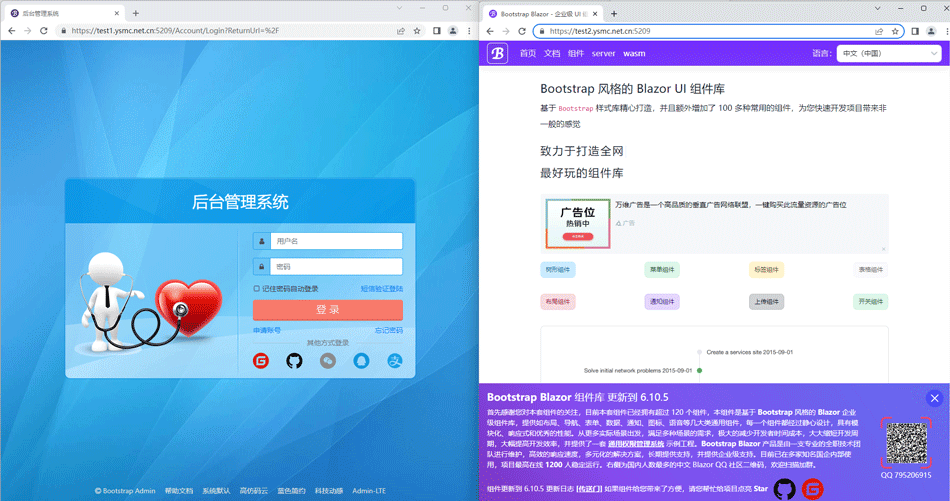.NET使用YARP通过编码方式配置域名转发实现反向代理
前面介绍了 YARP 通过配置文件的方式配置代理转发(传送门),而众所周知,微软的一贯作风就是能通过配置文件做的事情,通过编码的方式也能实现!YARP 也不例外,废话不多说,直接上代码!
首先,参照官方文档,我们先新建一个 InMemoryConfigProvider 类,并且继承 IProxyConfigProvider 接口,类里面还包含了一个 IProxyConfig 的类,别看漏了噢!
这里多嘴一下,下面的代码出现了 volatile 关键字,介绍一下它:volatile 是 C# 中用于控制同步的关键字,其意义是针对程序中一些敏感数据,不允许多线程同时访问,保证数据在任何访问时刻,最多有一个线程访问,以保证数据的完整性,volatile 是修饰变量的修饰符。
public class InMemoryConfigProvider : IProxyConfigProvider{ private volatile InMemoryConfig _config; public InMemoryConfigProvider(IReadOnlyList<RouteConfig> routes, IReadOnlyList<ClusterConfig> clusters) {_config = new InMemoryConfig(routes, clusters); } public IProxyConfig GetConfig() => _config; public void Update(IReadOnlyList<RouteConfig> routes, IReadOnlyList<ClusterConfig> clusters) {var oldConfig = _config;_config = new InMemoryConfig(routes, clusters);oldConfig.SignalChange(); } private class InMemoryConfig : IProxyConfig {private readonly CancellationTokenSource _cts = new();public InMemoryConfig(IReadOnlyList<RouteConfig> routes, IReadOnlyList<ClusterConfig> clusters){ Routes = routes; Clusters = clusters; ChangeToken = new CancellationChangeToken(_cts.Token);}public IReadOnlyList<RouteConfig> Routes { get; }public IReadOnlyList<ClusterConfig> Clusters { get; }public IChangeToken ChangeToken { get; }internal void SignalChange(){ _cts.Cancel();} }}然后添加一个扩展 InMemoryConfigProviderExtensions
public static class InMemoryConfigProviderExtensions{ public static IReverseProxyBuilder LoadFromMemory(this IReverseProxyBuilder builder, IReadOnlyList<RouteConfig> routes, IReadOnlyList<ClusterConfig> clusters) {builder.Services.AddSingleton<IProxyConfigProvider>(new InMemoryConfigProvider(routes, clusters));return builder; }}接下来就是写配置了,我个人还是喜欢在配置文件中写,但是有动态配置需求的话,又不想登录服务器编辑 appsetting 文件,通过编码的方式确实更为方便,将配置写进库或者其它存储方式里面,那将是随心所欲啊!上代码:
Program.cs
var routes = new[]{ new RouteConfig() {RouteId = "admin",ClusterId = "admin",Match = new RouteMatch{ Hosts = new string[] {"test1.ysmc.net.cn" }, Path = "{**catch-all}"} }, new RouteConfig() {RouteId = "blazor",ClusterId = "blazor",Match = new RouteMatch{ Hosts = new string[] {"test2.ysmc.net.cn" }, Path = "{**catch-all}"} }};var clusters = new[]{ new ClusterConfig() {ClusterId = "admin",LoadBalancingPolicy = "RoundRobin",Destinations = new Dictionary<string, DestinationConfig>(StringComparer.OrdinalIgnoreCase){ { "admin", new DestinationConfig() { Address = "https://admin.blazor.zone" } }} }, new ClusterConfig() {ClusterId = "blazor",LoadBalancingPolicy = "RoundRobin",Destinations = new Dictionary<string, DestinationConfig>(StringComparer.OrdinalIgnoreCase){ { "blazor", new DestinationConfig() { Address = "https://www.blazor.zone" } }} }};builder.Services.AddReverseProxy().LoadFromMemory(routes, clusters);上面的配置代码,跟配置文件方式的节点和属性,都是对应的,照着写就是了
"ReverseProxy": { "Routes": { "admin": { "ClusterId": "admin", "Match": {"Hosts": [ "test1.ysmc.net.cn" ],"Path": "{**catch-all}" } }, "blazor": { "ClusterId": "blazor", "Match": {"Hosts": [ "test2.ysmc.net.cn" ],"Path": "{**catch-all}" } } }, "Clusters": { "admin": { "LoadBalancingPolicy": "RoundRobin", "Destinations": {"admin": { "Address": "https://admin.blazor.zone/"} } }, "blazor": { "LoadBalancingPolicy": "RoundRobin", "Destinations": {"blazor": { "Address": "https://www.blazor.zone/"} } } }}最终效果还是依旧的完美,感谢大佬的观看,谢谢!

以上就是这篇文章的全部内容了,希望本文的内容对大家的学习或者工作具有一定的参考学习价值,谢谢大家对的支持。如果你想了解更多相关内容请查看下面相关链接
相关文章:
1. 如何将asp.net core程序部署到Linux服务器2. asp.net core应用docke部署到centos7的全过程3. .NET 中配置从xml转向json方法示例详解4. PHP:“草根语言”挑战“大腕”Java .Net5. ASP.NET MVC使用jQuery的Load方法加载静态页面及注意事项6. ASP.NET Core 依赖注入生命周期示例详解7. .Net Core和RabbitMQ限制循环消费的方法8. .net6 在中标麒麟下的安装和部署过程9. 使用 .NET MAUI 开发 ChatGPT 客户端的流程10. 实现.Net7下数据库定时检查的方法详解

 网公网安备
网公网安备